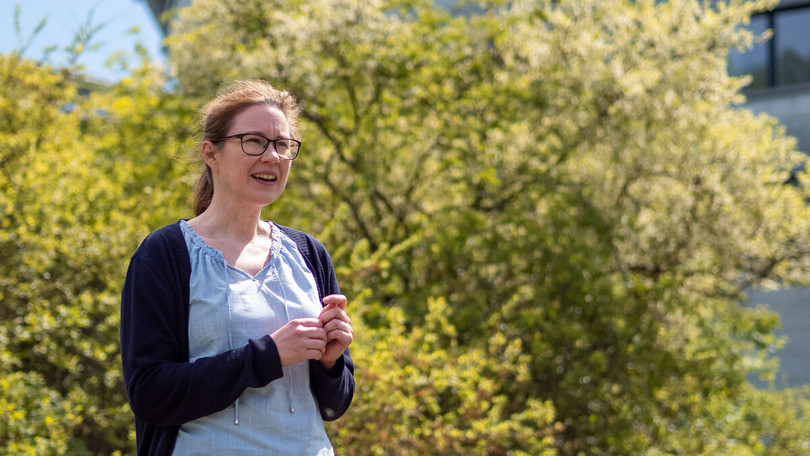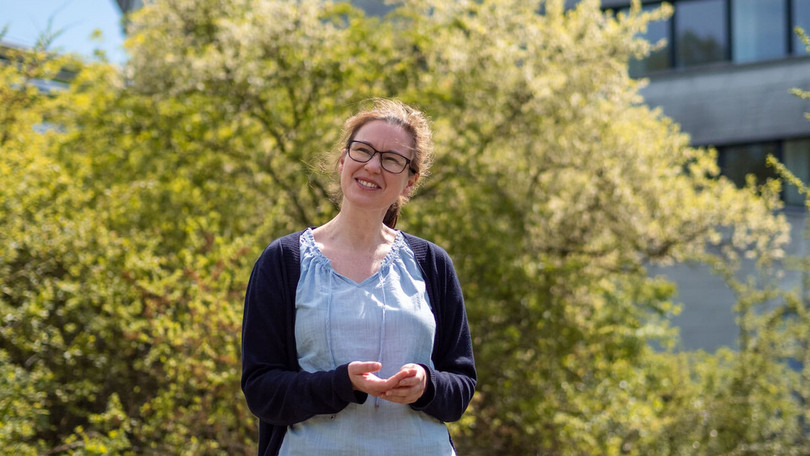New at Leuphana: Prof. Dr. Sylvia Haider
"In the mountains, the two-degree target has long been exceeded"
2023-08-04 The ecologist has taken over the professorship for vegetation ecology and biodiversity research. She can read climate change from the spread of certain plant species.
150 years ago, the species richness on Central European peaks was much smaller than it is today. What sounds like good news at first is an alarm signal: "Many plants can spread to higher regions because it is getting warmer there. In the mountains, the two-degree target has long been exceeded," says Prof. Dr. Sylvia Haider. She has taken over the professorship for vegetation ecology and biodiversity research. One of her research focuses is on dispersal patterns of native and non-native plant species along altitudinal gradients worldwide, which she investigates together with her colleagues from the Mountain Invasion Research Network "MIREN". "Often, non-native species are strong in dispersal. In the long run, they will probably displace the specialists in their microhabitats, at least locally. Mountains are biodiversity hotspots because there are still many climatic niches. But in the long run, we will lose biodiversity, not least due to the increasing influence of humans," the scientist explains. The consequences could be dramatic, as the stability of ecosystems is shaken by different migration speeds of different groups of organisms (e.g. insects can follow their climatic niche faster than plants).
Sylvia Haider expects species communities to become more uniform - worldwide. "We assume that in many cases it is the same species that spread particularly successfully. Local differences, the so-called beta diversity is lost as a result. It is conceivable that in many places there are predominantly the same 'all-world species', especially where humans disturb the natural species communities and thus promote the establishment of new species."
Often it is plants with small seeds that can spread well. The narrow-leaved greiskaut is an example of an introduced species that has been able to successfully establish itself in Central Europe. The yellow-flowered composite plant lines motorways, railway beds or slag heaps in autumn. "At the end of the 19th century, the plant came with wool transports from South Africa and was further spread by the railway," explains Sylvia Haider. The narrow-leaved ragwort is also influenced by climate change: "Studies have shown that this plant adapts to local climatic conditions through genetic differentiation. The southern French population, for example, is more sensitive to cold than plants sampled in Regensburg. In a field experiment, we found out that the warmth-loving populations benefit when it gets warmer overall. They will continue to spread."
Sylvia Haider is investigating how problematic a loss of biodiversity is for the functioning of ecosystems, such as the productivity of plant communities, in the BEF-China tree diversity experiment as part of the DFG-funded German-Chinese graduate school "TreeDì". A landscape with different species compositions was planted on about 40 ha in China: "Our studies show that trees in species-rich communities can make better use of the available resources, i.e. absorb more nutrients and water. A forest consisting of trees with shallow and long roots, for example, can draw more water from the soil than a forest in which only shallow-rooted trees grow," explains Sylvia Haider. The leaves in a species-rich forest can also utilise nutrients better than in a species-poor community. This ensures faster growth.
Sylvia Haider can tell a lot about environmental conditions from the size and thickness of a leaf, among other things: "With thick and small leaves, a plant protects itself from drying out, but also from extreme weather conditions like storms. Large, thin leaves ensure more efficient photosynthesis." In addition to morphology, Sylvia Haider and her team in the laboratory determine the nutrients in leaves as well as, for example, the content of plant phenols: "From the compositions we can see how well a plant protects itself against leaf feeding, for example, and thus how resistant it is."
Sylvia Haider is involved in various other national and international research projects: Among other things, she is cooperating with the Leibniz Institute of Plant Biochemistry on "Met-Total". The habitat-dependent metabolic diversity is being investigated. Sylvia Haider is also part of the research team at the Global Change Experimental Facility of the Helmholtz Centre for Environmental Research, where the consequences of climate change for ecosystem processes in different land use types are being studied in a large long-term field experiment. She has also been observing the impact of fertilisation on grassland communities for many years as part of the global Nutrient Network.
Sylvia Haider studied landscape architecture and landscape planning at the TU Munich. Until 2011, she was a research assistant at the TU Munich, specialising in landscape ecology, renaturation ecology and terrestrial ecology, and completed her doctorate in cooperation with the ETH Zurich on the topic of "Altitudinal distribution of non-native plants: the effects of climate, habitat and introduction history". As scientific coordinator, she organised TUMbiodivers. In 2012 she moved to MLU Halle-Wittenberg and became a member of the German Centre for Integrative Biodiversity Research (iDiv) Halle-Jena-Leipzig. In 2023, she has been appointed to Leuphana University Lüneburg.



